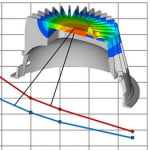 Demand for thermally conductive thermoplastics is growing in many industries. This particularly applies to the automotive industry, the electrical and electronics industry, and lighting technology. One reason for this is the miniaturization of electrical and electronic components, which results in more heat being generated inside devices. In addition, many manufacturers want to take advantage of the significant freedom in design and the benefits that thermoplastics often offer in contrast to metals when it comes to processing and cost effectiveness.
Demand for thermally conductive thermoplastics is growing in many industries. This particularly applies to the automotive industry, the electrical and electronics industry, and lighting technology. One reason for this is the miniaturization of electrical and electronic components, which results in more heat being generated inside devices. In addition, many manufacturers want to take advantage of the significant freedom in design and the benefits that thermoplastics often offer in contrast to metals when it comes to processing and cost effectiveness.As a result, LANXESS is expanding its Durethan TC (thermally conductive) polyamide product line for thermal management in electrical and electronic devices. “The compounds are specifically designed with additional properties depending on their area of use which benefit the respective applications. This includes, for example, a high level of flame retardancy, excellent mechanical behavior, outstanding resistance to thermal aging, or high reflectivity,” explains Christof Boden.
The expert who works in application development at LANXESS also believes the structural materials have another advantage: “Because of their high content of thermally conductive particles, the compounds have a comparably high density, which means they feel good to the touch and can be used to create components with a perceived quality similar to those made of metal.”
High reflectivity and flame retardancy
One highlight of the TC line is a new polyamide 6 that combines excellent thermal conductivity with high reflectivity, flame retardancy, and tracking resistance. Its thermal conductivity is direction-dependent due to the mineral filler particles and equals 2.5 watts per meter-kelvin in the direction of melt flow (Nanoflash method).The trial product is halogen-free flame retardant and achieves the best classification of V-0 (0.75 millimeters) in testing pursuant to the United States’ UL 94 (Underwriter Laboratories Inc.) standard for safety of flammability of plastic materials. The results of glow wire testing pursuant to IEC 60695-2-12/13 are also impressive, with the compound achieving the best possible classification (0.75 millimeters) in the GWFI (Glow Wire Flammability Index) test, at 960 °C. With a CTI (Comparative Tracking Index, IEC 60112) value of 600 volts, the compound also exhibits particularly high tracking resistance. Despite the significant concentration of thermally conductive particles, the compound can be processed just as well as polyamide 6 types with high contents of glass fibres and exhibits a similarly low level of tool abrasion. The compound’s areas of application range from heat sinks and support profiles for LED lights to LED cooling fins for automotive headlamps to housings and cell holders for battery systems.



